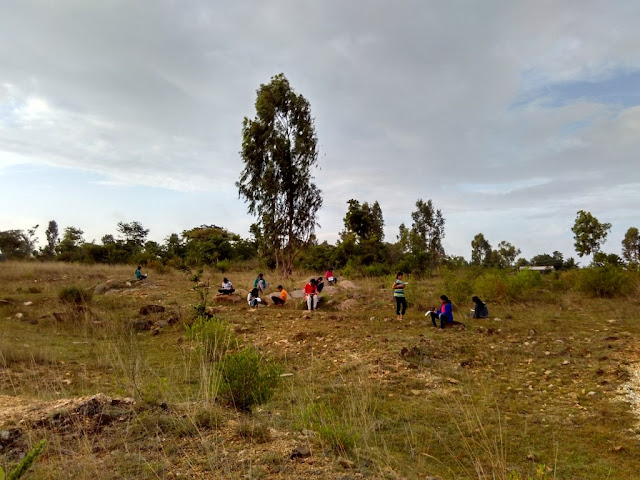 |
| An outdoor session on weathering of Rocks. - B S Guruprasad |
The batch of students that arrived from TVS School, Hosur
really looked like a bus load. The school had always sent about 34 children of
a single class and we had meticulously mastered in handling them. The facility
at camp site was more than ideal for that. This time it was 45 children and four teachers
making it slightly tight. These grade
six students were on their maiden outing and most of them had never stayed in
the wilderness area overnight without their parents. The culture of outdoor
discipline and conduct was yet to be sown in them. The persistent non attention
to the class and to the instructions of teachers suggested that they were still
afresh to classroom etiquette. Everybody seemed very enthusiastic but above reasoning.
 |
| Some instructions to begin with. - B S. Guruprasad |
Even as we tried to put things in order and gain confidence
and affection of children through luring them to rewards the basic infrastructure
at the camp site was letting us down. The Hosa
Jevana Dari campus was in a transition and was getting upgraded with its
dormitory and facility for stay. Some of
the old structures were being thoroughly re-done and in the process there was
an acute shortage of washrooms. We were losing time in recesses than in any
activity.
Obviously our first option for a strategy to handle these
children was to have sufficient physical activities instead of any classroom
teaching. So we had some wonderful treks
and climbs as a main course for the camp. The weather cooperated and there was
an alteration of sunshine, cloud and pleasant drizzling. After lunch we set off
for a short walk involving some rambling up the rock strewn hillocks of the
Melkote Wildlife sanctuary. The area provided a live backdrop for some
narration about the types of weathering. There was every stage of the weathering
process of a monolithic rock and the formation of soil.
 |
| Children in the ravines of Melkote - Manu K |
The following morning we had a start at 6.30 am and divided
the class into four smaller batches. They all moved out into open fields
outside the campus with different resource persons. They were made to choose an object and sit
recording their observations of the same.
 |
Learning Options in Nature: Sky is the limit - Manu K
|
 |
| A child engrossed in sketching a cassia flower - Manu K |
No matter doing what. Some watched birds and some plants and some studied the landscape. They were later made to present their observations and resource persons made their comments upon it and enhanced their understanding. Children thoroughly enjoyed the activity and nobody remembered the washroom!
Research shows that empathy and love of nature grows out of
children’s regular contact with the natural world. Frequent, positive early childhood experiences with nature has shown to have a outing, the breakfast the
children had another stretch to walk and climb.
 |
But before we embarked on that outing
children were made to sit and the relevance of the Hiroshima Day was discussed.
Some 70 years ago on the same day same time, people of
Hiroshima town in Japan were starting their day under the bright sunshine. An
American aircraft flies over the sky and an alarm siren is blown and all the
civilians run helter-shelter for cover under the bomb protective bunkers for
shelter. Nothing happens for half an hour and just as the public come out of
their cover there are three more aircraft seen high over the sky.
They drop
the first atomic bomb used against any nation in the world. The whole city is
devastated within seconds. People get burnt and annihilated to black soot
killing more than 50 thousand people instantly. A white cloud rises from the epicenter towards the sky forming a mushroom shaped cloud which later spread
out as a black cloud and precipitate over the devastated town with droplets of
thick car. Without any drinking water, the survivors consume the toxic fluid and
get exposed to radiation. A further thirty thousand victims will have a slower
death. The narration was well received and children started a debate about the
choice of people under various types of governments.
Later on there was a long trek across the ravines of around
the gavikallu gudda, the highest peak
in the sanctuary. The scant rains that only appear occasionally in these
valleys was enough to turn the landscape lush green. The cloudy weather kept
the team going without breaks. Strictly
speaking ‘break’ meant some interesting specimen to be understood. We stood at
anthills and a lovely old specimen of Cycas plant.
We did some climbing
upon a base rock and the children felt proud of themselves after having gone
through it. By evening they were exhausted and for the Audiovisual we had the
screening of a documentary on Hiroshima.


No comments:
Post a Comment